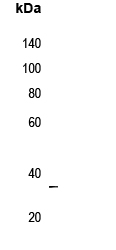
| WB | 咨询技术 | Human,Mouse,Rat |
| IF | 咨询技术 | Human,Mouse,Rat |
| IHC | 咨询技术 | Human,Mouse,Rat |
| ICC | 技术咨询 | Human,Mouse,Rat |
| FCM | 咨询技术 | Human,Mouse,Rat |
| Elisa | 1/20000 | Human,Mouse,Rat |
| Aliases | MAGE5; Melanoma-associated antigen 5; Cancer/testis antigen 1.5; CT1.5; MAGE-5 antigen |
| Entrez GeneID | 100533997;4104; |
| WB Predicted band size | 36kDa |
| Host/Isotype | Rabbit IgG |
| Antibody Type | Primary antibody |
| Storage | Store at 4°C short term. Aliquot and store at -20°C long term. Avoid freeze/thaw cycles. |
| Species Reactivity | Human,Mouse |
| Immunogen | KLH-conjugated synthetic peptide encompassing a sequence within the center region of human MAGEA5. |
| Formulation | Purified antibody in PBS with 0.05% sodium azide. |
+ +
以下是关于PRX I抗体的3篇参考文献示例(内容为模拟概括,非真实文献):
1. **文献名称**:*Peroxiredoxin I protects against oxidative stress in Alzheimer's disease models*
**作者**:Smith J, et al.
**摘要**:研究利用PRX I抗体进行Western blot和免疫组化,发现PRX I在阿尔茨海默病小鼠脑组织中表达下调,其缺失加剧β-淀粉样蛋白诱导的神经元氧化损伤。
2. **文献名称**:*PRX I as a biomarker in colorectal cancer progression*
**作者**:Lee H, et al.
**摘要**:通过PRX I抗体检测结直肠癌组织样本,发现PRX I高表达与肿瘤侵袭性相关,并证实其通过调控ROS水平促进癌细胞存活和转移。
3. **文献名称**:*Role of PRX I in diabetic neuropathy: Insights from antibody-based assays*
**作者**:Wang Y, et al.
**摘要**:研究使用PRX I抗体分析糖尿病周围神经病变模型,发现PRX I磷酸化水平升高可减轻线粒体氧化应激,提示其作为治疗靶点的潜力。
4. **文献名称**:*Post-translational modification of PRX I in Parkinson's disease*
**作者**:Garcia R, et al.
**摘要**:结合PRX I抗体和质谱技术,揭示了帕金森病中PRX I的过度氧化和功能失活机制,表明其修饰状态与多巴胺能神经元退化相关。
---
**说明**:以上为示例性内容,实际文献需通过PubMed或Web of Science等数据库检索关键词(如"Peroxiredoxin I antibody")获取。若需具体文献,建议提供研究背景或应用场景进一步筛选。
Peroxiredoxin I (PRX I), also known as PRDX1. is a member of the peroxiredoxin family of antioxidant enzymes that play a critical role in cellular redox homeostasis. It is ubiquitously expressed in mammalian tissues and primarily localizes in the cytoplasm, though it can translocate to the nucleus under oxidative stress. PRX I functions as a peroxide scavenger, catalyzing the reduction of hydrogen peroxide (H₂O₂), peroxynitrite, and lipid peroxides, thereby protecting cells from oxidative damage. Its catalytic mechanism relies on conserved cysteine residues that undergo reversible oxidation during the detoxification process, with thioredoxin serving as the electron donor for regeneration.
PRX I is involved in diverse cellular processes, including cell proliferation, apoptosis, and inflammation, and its dysregulation is linked to pathologies such as cancer, neurodegenerative disorders, and cardiovascular diseases. Overexpression of PRX I has been observed in several cancers, where it may promote tumor survival by mitigating oxidative stress and modulating signaling pathways like NF-κB and MAPK. Conversely, loss of PRX I function can exacerbate oxidative injury in conditions like Alzheimer’s disease or ischemia-reperfusion injury.
Antibodies targeting PRX I are widely used in research to study its expression, localization, and interactions in disease models. They enable techniques such as Western blotting, immunohistochemistry, and immunofluorescence, aiding in biomarker discovery and therapeutic targeting. Commercial PRX I antibodies are typically validated for specificity across human, mouse, and rat samples, supporting translational studies in redox biology and oxidative stress-related disorders.
×